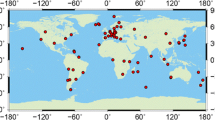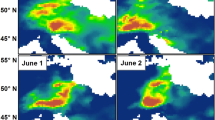Abstract
The zenith tropospheric delay (ZTD) is a significant error source which affects the GPS signal propagation time. ZTD time series can directly or indirectly reflect the weather variations. In geodetic studies their computation is important since it improves position accuracy. Sophisticated software packages using network data of ground-based GPS receivers are used for this purpose. During the last years, various web based precise point positioning (PPP) services can provide position solutions. Additional products, such as ZTD estimates, can be derived both from PPP as well as from network solutions. Research institutes and laboratories like JPL provide similar services. This study’s objective is twofold. In a first instance we used the Bernese and GAMIT software packages and the PPP service via the JPL webpage to estimate ZTD values every hour for a period of one month. We selected a geographical area in Greece, where seasonal weather variations are frequent and GPS permanent station infrastructure is available. The estimated ZTD values derived from GPS processing for a single station were compared with the ZTD estimates derived directly from the Saastamoinen model using meteorological data from a co-located meteorological sensor as input to this model. The results show an rms agreement of about 45 mm. The second scope of this study is to compare precipitable water (PW) values between different processing schemes. For this purpose, we used the derived zenith wet delay estimates of each processing scheme and a global formula for the computation of the weighted mean temperature of the atmosphere for our area of study. The rms differences between the web PPP solution and the Bernese derived estimates were 0.35 mm. The rms of the differences between and the web PPP solution and the GAMIT derived estimates of PW were 1.67 mm. We conclude that this difference follows from the zenith hydrostatic delay component that needs to be properly modeled when high accuracy results are required.







Similar content being viewed by others
References
Bevis M, Businger S, Herring TA, Rocken C, Anthes RA, Ware RH (1992) GPS meteorology: remote sensing of atmospheric water vapor using the Global Positioning System. J Geophys Res 97:15784–15801
Bevis M, Businger S, Chiswell SR, Anthes RA, Rocken C, Ware RH (1994) GPS meteorology: mapping zenith wet delay onto precipitable water. J Appl Meteorol 33:379–386
Boehm J, Niell A, Tregoning P, Schuh H (2006a) Global mapping function (GMF): a new empirical mapping function. Geophys Res Lett 33:L07304. doi:10.1029/2005GL025546
Boehm J, Werl B, Schuh H (2006b) Troposphere mapping functions for GPS and very long baseline interferometry from European Centre for Medium-Range Weather Forecasts operational analysis data. J Geophys Res 111:B02406. doi:10.1029/2005JB003629
Bruyninx C (2004) The EUREF Permanent Network: a multi-disciplinary network serving surveyors as well as scientists. Geoinformatics 7:32–35
Businger S, Chiswell SR, Bevis M, Duan J, Anthes RA, Rocken C, Ware RH, Exner M, VanHofe H, Solheim F (1996) The promise of GPS in atmospheric monitoring. Bull Am Meteorol Soc 77(1):5–18
Dach R, Hugentobler U, Fridez P, Meindl M (2007) Bernese GPS software version 5.0. Astronomical Institute, University of Bern, Switzerland
Davis JL, Herring TA, Shapiro II, Rogers AE, Elgered G (1985) Geodesy by radio interferometry: effects of atmospheric modeling errors on estimates of baseline length. Radio Sci 20:1593–1607
Duan J, Bevis M, Fang P, Bock Y, Chiswell ST, Businger ST (1996) GPS meteorology: direct estimation of the absolute value of precipitable water. J Appl Meteorol 35:830–838
Emardson T, Derks H (2000) On the relation between the wet delay and the integrated precipitable water vapour in the European atmosphere. Meteorol Appl 7:61–68
European Centre for Medium-Range Weather Forecasts (ECMWF) (2014) Internet resources. http://www.ecmwf.int/. Accessed 13 Jan 2014
Fotiou A, Pikridas C (2012) GPS and geodetic applications, 2nd edn. Editions Ziti, Thessaloniki
Herring TA (2003) GLOBK Global Kalman filter VLBI and GPS analysis program version 10.1, internal memorandum. Massachusetts Institute of Technology, Cambridge, MA, USA
Herring TA, King RW, McClusky SC (2010) GAMIT reference manual: GPS analysis at MIT. Department of Earth Atmospheric and Planetary Science, Massachusetts Institute of Technology, Cambridge, MA, USA
Houssos EE, Lolis CJ, Gkikas A, Hatzianastassiou N, Bartzokas A (2012) On the atmospheric circulation characteristics associated with fog in Ioannina, North-Western Greece. Int J Climatol 32:1847–1862
Karabatic A, Weber R, Haiden T (2011) Near real-time estimation of tropospheric water vapour content from ground based GNSS data and its potential contribution to weather now-casting in Austria. Adv Space Res 47:1691–1703
Katsougiannopoulos S (2008) Study of tropospheric effect on GNSS signals. Application to the European area. PhD thesis, Department of Geodesy and Surveying, Aristotle University of Thessaloniki, Greece
Mendes VB, Prates G, Santos L, Langley RB (2000) An evaluation of the accuracy of models of the determination of the weighted mean temperature of the atmosphere. In: Proceedings of ION, 2000 national technical meeting, Jan 26–28, Pacific Hotel Disneyland, Anaheim, CA
Niell AE (1996) Global mapping functions for the atmosphere delay at radio wavelengths. J Geophys Res 101(B2):3227–3246
Rózsa S (2014) Uncertainty considerations for the comparison of water vapour derived from radiosondes and GNSS. Int Assoc Geod Symp 139:65–78
Saastamoinen J (1972) Atmospheric correction for the troposphere and stratosphere in radio ranging of satellites. In: Henriksen SW, Mancini A, Chovitz BH (eds) The use of artificial satellites for geodesy. Geophysical monograph series, vol 115. AGU, Washington, DC, pp 247–251
Schuler T (2001) On ground-based GPS tropospheric delay estimation. PhD thesis, Institute of Geodesy and Navigation, University FAF, Munich, Germany
Sindosi OA, Bartzokas A, Kotroni V, Lagouvardos K (2012) he impact of topography on the precipitation regime over Epirus, NW Greece, during the cold period of the year. In: Helmis CG, Nastos P (eds) Advances in meteorology, climatology and atmospheric physics. Proceedings of COMECAP 2012. Springer atmospheric sciences. Springer, Berlin, pp 285–291
Vazquez GE, Brzezinska D (2012) GPS-PWV estimation and validation with radiosonde data and numerical weather prediction model in Antarctica. GPS Solut. doi:10.1007/s10291-012-0258-8
Zumberge JF, Heflin MB, Jeferson DC, Watkins MM, Webb FH (1997) Precise point positioning for the efficient and robust analysis of GPS data from large networks. J Geophys Res 102(B3):5005–5017
Acknowledgments
We would like to thank the Associate Prof. Aristidis Bartzokas and lecturer Dr. Christos Lolis from University of Ioannina for provide us with the ground measurements of meteorological station established by Laboratory of Meteorology.
Author information
Authors and Affiliations
Corresponding author
Rights and permissions
About this article
Cite this article
Pikridas, C., Katsougiannopoulos, S. & Zinas, N. A comparative study of zenith tropospheric delay and precipitable water vapor estimates using scientific GPS processing software and web based automated PPP service. Acta Geod Geophys 49, 177–188 (2014). https://doi.org/10.1007/s40328-014-0047-7
Received:
Accepted:
Published:
Issue Date:
DOI: https://doi.org/10.1007/s40328-014-0047-7




